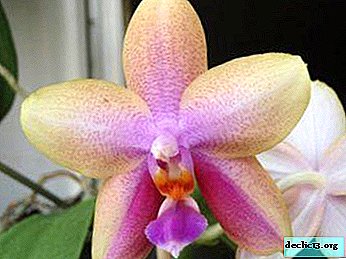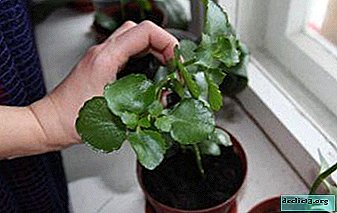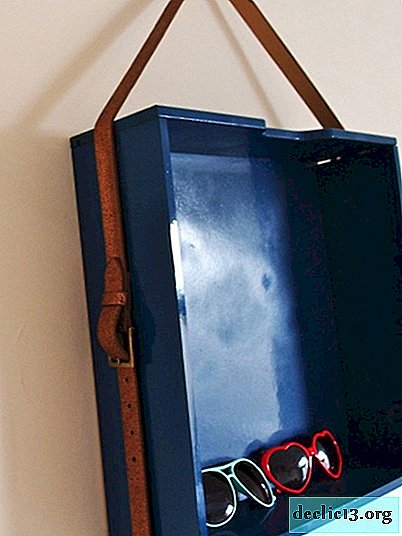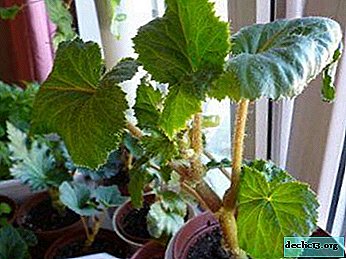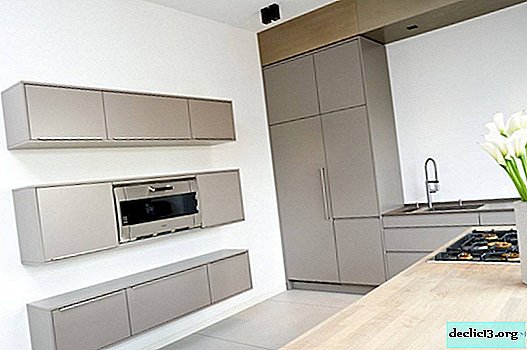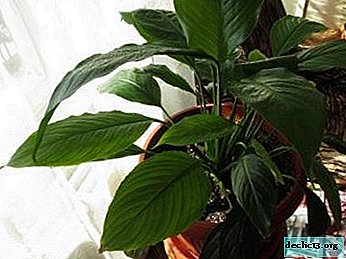A popular variety among gardeners is the lover of Erinus: a photo of the flower and its care
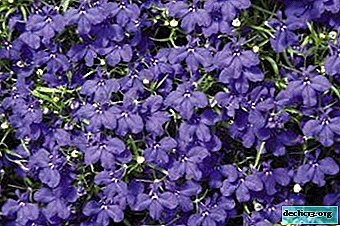
Lobelia Erinus is the most popular variety from all the numerous variety of the lobelia genus. Differs in generosity and duration of flowering, creates a unique flavor of flower beds and flower beds.
Next, we dwell on the subspecies of this flower: description, photo. We will show you when it is best to plant and what soil is needed for successful growth and flowering. Let's talk about the existing methods of reproduction and how to properly carry them out. Do you need pruning, as well as about the rules of care.
Appearance and habitat
Natural varieties grow in South Africa, in modern floriculture, the flower is distributed throughout the world. Lobelia Erinus is called long-leaved for the structural features of the bush. The variety belongs to perennials, although in floriculture it is used as an annual shrub of the bellflower family.
The bush is stunted, grows no more than 20 - 25 cm in height. Shoots strongly branch, the branches of ampelous varieties of this variety reach up to 40 cm in length. Shoots are densely covered with leaves. The leaves are small, oblong, the edges are jagged, have a dense structure, shiny, dark green with a bronze tint. Read more about the most beautiful and unpretentious varieties of ampel lobelia in this article.
The flowers are small, up to 2 cm in diameter. Inflorescences are dense, tightly pressed against each other, which ensures the compactness of a spherical crown. The colors are diverse, saturated tones of blue, purple, white. Propagated most often by seeds. Ampelic varieties, due to the long hanging stems, reproduce well by layering.
Florists conditionally distinguish 5 forms of Erinus lobelia based on the formation of a bush and crown:
- Sprawling - shoots no more than 30 cm, bush height - 10 - 15 cm.
- Drooping - ampelous - shoots up to 40 cm.
- Compact - the bush grows to 20 cm, the crown is spherical.
- Upright - the stems grow upwards, with a height of 20 - 30 cm.
- Dwarf - the bush reaches up to 10 - 12 cm in height.
Subspecies: description and photo
White Palace
The flower is grown as an annual. The bush is stunted, grows up to 10 - 15 cm. The crown is compact, densely planted with flowers and leaves. The stalks densely branch. The flowers are tiny, white, with a diameter of 1 - 1.5 cm. The leaves are bright with a bronze tint, dense, small, grow alternately, completely covering the stem.
The variety grows well in open areas, on balconies and in apartment conditions. Flowering begins in June, lasts until the frost. It is mainly propagated by seeds. It grows on loose, moderately fertile soils. The variety is heat-loving, requires a lot of light and moisture.

Crystal palace
The variety belongs to perennial herbaceous plants. In floriculture it is used as an annual flower. Lobelia The Crystal Palace forms a short, dense compact bush with a height of not more than 12 - 15 cm. The crown is lush, spherical. The branches are thin, branching straight from the base.
The leaves are small, oblong, dense in structure, grow alternately. The leaves are densely planted on the stems, a bright bronze hue. The colors of the petals are blue, saturated - purple, cornflower blue, depending on the sub-grade. The flowers are small, curly, up to 2 - 3 cm in diameter.
Abundant flowering, begins in mid-June, lasts until the end of September. Most often used for the design of gardens and parks, usually planted varieties along borders, in flower beds.

Royal Palace
Grown as an annual flower. It forms a compact dwarf bush with a height of not more than 10 cm. The crown of the bush is spherical, dense. Branches are dense, highly branched. The variety is often called lobelia climbing due to the structure of the branches.
On a note. Flowering begins in June, with proper care continues until September.The flowers are deep crimson, miniature 1 - 2 cm in diameter. The buds are small, inflorescences are located close to each other, which provides a generous flowering.
The leaves are bright, dense, shiny, oblong, densely planted over the entire surface of the stem, grow alternately. The variety prefers sunny places, well-moistened soils. Propagated mainly by seeds, seedlings perfectly take root in open fields, in pots, on balconies and open verandas.

Landing Features
Which season is better?
Lobelia is propagated mainly by seeds. Even at home, you can independently grow seedlings in a greenhouse. Sown seeds in the winter, the process is long and painstaking. In the open ground, planting usually begins in May, when there is no threat of night frost.
The soil
The soil for this variety should be loose, moderately fertile. The composition of the soil mixture for planting Erinus lobelia:
- Garden land - 1 hour
- Vermiculite - 1 hour
For sowing seeds, sandy soil mixtures are often used:
- Sand - 1 hour
- Ordinary garden land - 1 hour
- Humus - 0.5 hours
Soil is usually prepared in the fall, left on an unheated balcony so that it freezes well in winter. Many flower growers are calcined in the oven or steamed before sowing.
Methods
Seeds
 Sowing seeds is done in late February, sometimes in January, but then additional illumination is required. The difficulty with this method is that the procedure for growing seedlings from seeds is laborious and lengthy. In the first stage of growth, lobelia grows very slowly.
Sowing seeds is done in late February, sometimes in January, but then additional illumination is required. The difficulty with this method is that the procedure for growing seedlings from seeds is laborious and lengthy. In the first stage of growth, lobelia grows very slowly.
The advantage of sowing seeds is the reliability of the method. Seedlings obtained by self-sowing, is characterized by 100% quality of future flowering, it survives well even in open ground, does not get sick and resists garden pests and diseases.
How to choose?
Erinus lobelia seeds have a rather long "shelf life"retain their qualities up to 4 years. Seeds have structural and size features - only 1 g contains up to 30 thousand seeds. For planting 1 flower bed, you need only 0.5 grams.
To distribute them evenly in the greenhouse, the seeds are usually mixed with sand and peat, in a ratio of 1: 5, or planted on snow, previously spread out with a thin layer, up to 1 cm thick, on the surface of the substrate.
Note! When sowing, the seeds are not embedded in the soil, only slightly pressed to it.Procedure
Sowing Erinus lobelia seeds is usually carried out in late February. Since the fall, the soil mixture has been prepared:
- Sod land - 1 h.
- Horse peat - 1 h.
- Sand - 1 hour
Humus should not be added to the substrate for sowing - sprouts can be affected by the fungus of the Black Leg.
The landing box or container should be low and spacious, you can use a food container with a transparent lid. Seeds ripen only in good light, so most often the crops are highlighted additionally with special lamps.
The procedure for planting Erinus lobelia seeds is performed sequentially:
 Ready substrate is poured into the landing container, in a small layer up to 5 cm.
Ready substrate is poured into the landing container, in a small layer up to 5 cm.- Moisten the substrate, slightly compact.
- Seeds mixed with sand or peat are sown.
- Sowing is not sprinkled with a substrate.
- Sowing is moistened evenly from a fine sprayer.
- The container is covered with glass or film.
- Air every day for 20 minutes, gradually increasing the airing time to 1.5 - 2 hours.
- Condensation must be wiped off the film.
- Shoots appear after 7 to 9 days with thick bristles.
- Watering is carried out only by spraying.
- The film or glass is removed completely when the sprouts grow to 3 cm so that the seedlings are tempered.
- A month after sowing, a pick is required - a sprout transplant.
- A pick is usually carried out with a teaspoon or a special spatula.
- Transplant 6 sprouts into separate small pots or peat cups.
- As soon as the seedlings reach 2.5 - 3 cm in height, the tops must be cut.
- Pruning is carried out 2 to 3 times every 3 to 4 weeks for good tillering of the flower.
- Air temperature for seed germination - not less than 19 ° С.
For primary hydration immediately after planting, it is advisable to add potassium permanganate to the water to disinfect the substrate and prevent seedlings diseases. Watering should be neat, moderate.
Cuttings
Propagation of erinus lobelia by cuttings is rarely used., only with those hybrid varieties that do not produce seeds.
It is necessary to prepare in advance the soil for cuttings, select the desired capacity, follow all the rules of care and growing.
Advantages and disadvantages
This method can only be used for varieties with double flowers and Erinus lobelia hybrids. Propagation by cuttings does not take much time, rooting of cuttings is quick, the procedure itself is simple.
Training
 Erinus usually uses an adult bush to propagate lobelia., with well developed and healthy, strong shoots. They dig a flower at the end of autumn and transfer it to the house for wintering. They look after other indoor flowers, the temperature of the content is 18 - 20 ° С.
Erinus usually uses an adult bush to propagate lobelia., with well developed and healthy, strong shoots. They dig a flower at the end of autumn and transfer it to the house for wintering. They look after other indoor flowers, the temperature of the content is 18 - 20 ° С.
Cuttings are cut in the spring. The tops of shoots are cut off with a length of 8 - 10 cm. Before planting, it is advisable to treat the slices with any growth stimulator, usually root is used.
You can independently prepare the mixture for cuttings:
- River sand - 1 hour
- Vermiculite - 1 hour
Step-by-step instruction
Cuttings are usually carried out in March, so that the seedlings get stronger for planting in open ground.
The propagation scheme by cuttings of lobelia Erinus:
- Cuttings are cut obliquely up to 10 cm long.
- The base is treated with a growth stimulator.
- Cuttings are planted in a pre-prepared sand mixture.
- Seedlings are covered with a film or a glass jar.
- Aeration of cuttings is required every day for 20 minutes.
- Rooting conditionally occurs after a month.
- Top dressing is applied once a week.
- Most often they use liquid complex mineral fertilizers.
- After 1, 5 months from the time of planting, seedlings are transplanted into open ground on flower beds or flower beds.
Outdoor cultivation
In the southern regions and in places with a temperate climate, seedlings are planted in open ground in May. For hardening, the container with seedlings is taken out to fresh air, gradually increasing the time to 2–3 hours per day.
The scheme for planting Erinus lobelia in the ground:
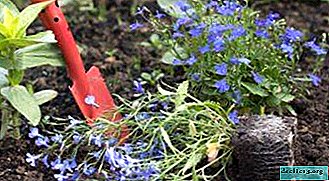 Digging landing holes, shallow, 2 cm wider than the root system.
Digging landing holes, shallow, 2 cm wider than the root system.- The distance between the planting bushes should be at least 20 cm.
- Three to four seedlings are placed in one hole for planting density.
- Moisten the substrate, slightly tamp.
For ease of transplantation into open ground, the substrate is moistened in a temporary container and on the landing site. When planting, an earthen seedlings should be preserved for quick rooting in new conditions.
Does the flower tolerate frost?
Erinus lobelia variety does not tolerate frost, gardeners at the end of the season - October - November dig bushes. Flowers are usually transplanted in pots, keeping an earthen lump. Install in warm places, with adequate lighting. Ampel varieties of Erinus are transplanted into hanging baskets.
Timely transplanted Erinus lobelia flowers, with proper care, continue to bloom on the windows even in winter.
Leaving: temperature, watering, light, pruning and top dressing
- The place of planting or keeping the pots should be bright, but you need to warn against direct sunlight. Lobelia is best placed on the eastern or western parts of the house.
- The temperature of the flowers is 20 - 22 ° C.
- Fertilizers should be metered and moderate. Top dressing with nitrogen fertilizers and organics is contraindicated, flowering becomes sparse, only the green mass of the flower grows. It is enough to fertilize once a week with complex mineral fertilizers.
- Trimming and pinching. Immediately after flowering, pruning of bushes by 5-6 cm is necessary, this forms a beautiful bush and allows new buds to appear. Repeated flowering in August is possible.
Important: to conduct timely pinching of seedlings - the tops of the stem are gently broken off or cut off. Thanks to pinching, the bush evenly develops in height and width, and branches well.
- Watering the seedlings should be plentiful, 1-2 times a week. You can add spraying bushes, while maintaining the freshness of green foliage. In autumn and winter, watering is reduced. The method of watering is to water under the root, water should not fall on flowers and leaves. In winter, watering is reduced.
Watering should only be done early in the morning or in the evening, so that water does not cause burns on the leaves.
- Pots, hanging flower pots, flowerpots, landing containers should be spacious, medium height, a prerequisite - drainage holes for water drainage.
Lobelia is completely unpretentious and available to any grower - an amateur. You should only adhere to the simple rules of care, trim in time, and picturesque flower beds can decorate the garden all summer.

 Ready substrate is poured into the landing container, in a small layer up to 5 cm.
Ready substrate is poured into the landing container, in a small layer up to 5 cm. Digging landing holes, shallow, 2 cm wider than the root system.
Digging landing holes, shallow, 2 cm wider than the root system.



